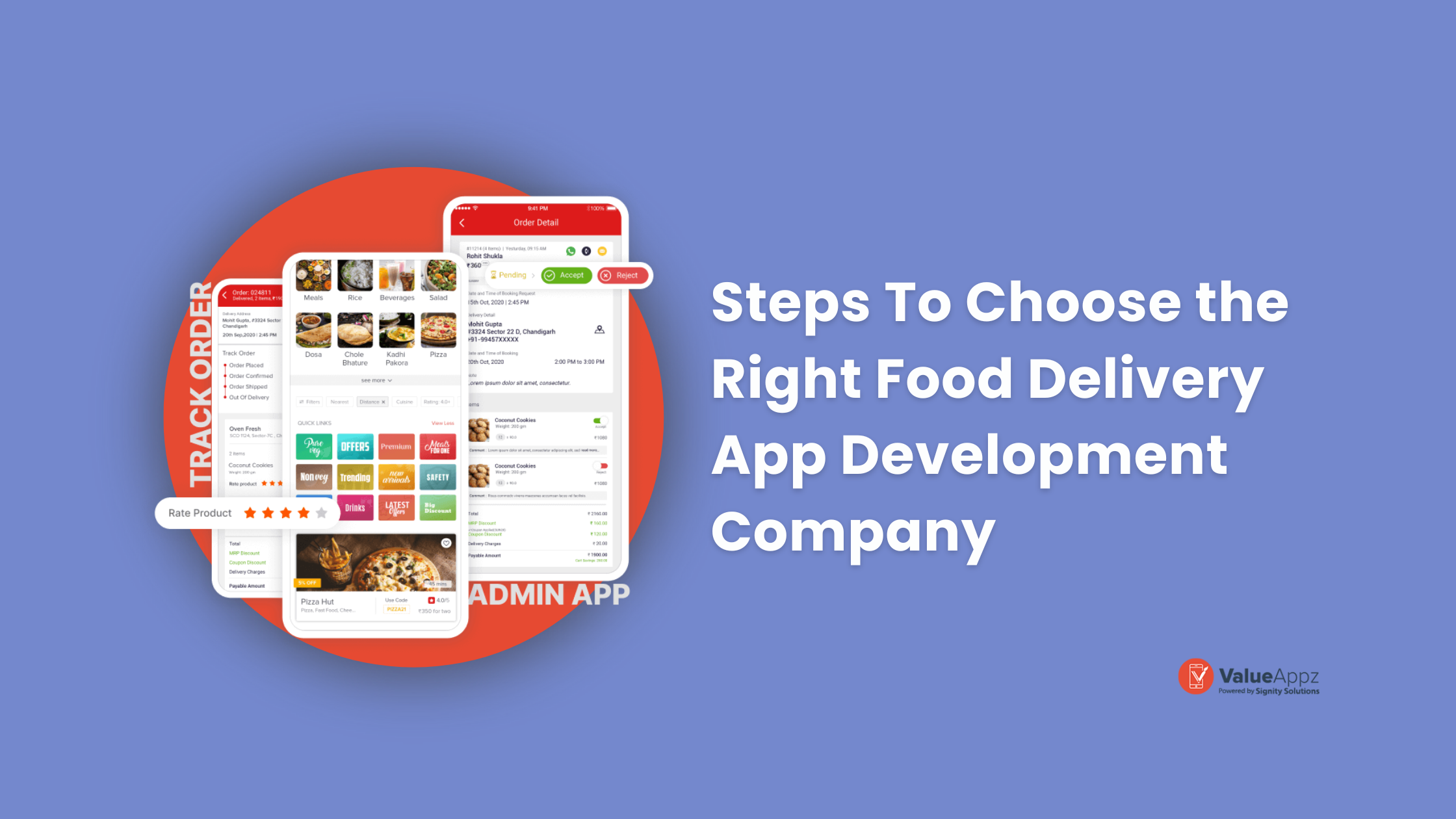Gojek Business Model and Revenue Channels Explained

Quick Summary: Gojek is a super app that renders several services under one platform. It attracts various target audiences through the website and application. This blog will help you discover Gojek’s business model, how Gojek makes money, a list of services, and its complete history.
Asian countries are not behind the Western countries when it comes to listing successful startups, especially in the on demand delivery industry.
One such is the story of Gojek- a super app that provides several on demand services under one platform. Originated in Indonesia, the app is now present in three countries.
From becoming Indonesia’s first decacorn to attracting millions of customers, reaching 30 million monthly bookings, Gojek has achieved many milestones.
This blog is a complete guide to how this brand became a super app, its business model, its list of services, and how it makes money.
So, let’s get started on discovering the success of Gojek.
Table of Contents
Gojek- A Super App that Originated in Indonesia
What is a super app? A super app is a mobile app that provides several services and functionalities within a single platform. It does so to meet various user needs without having to switch between multiple apps.
Gojek- which originated in Indonesia, is one of the leading super apps that has met the requirements of millions of its customers. From delivering food to booking taxis, ordering groceries, etc., the list keeps going on. Its complete list of services is explained in the section below. Keep scrolling to read.
Gojek History- Its Growth Over the Years
Gojek has seen a remarkable journey ever since its launch. Let’s look at how this brand has been established with each passing year since its launch.
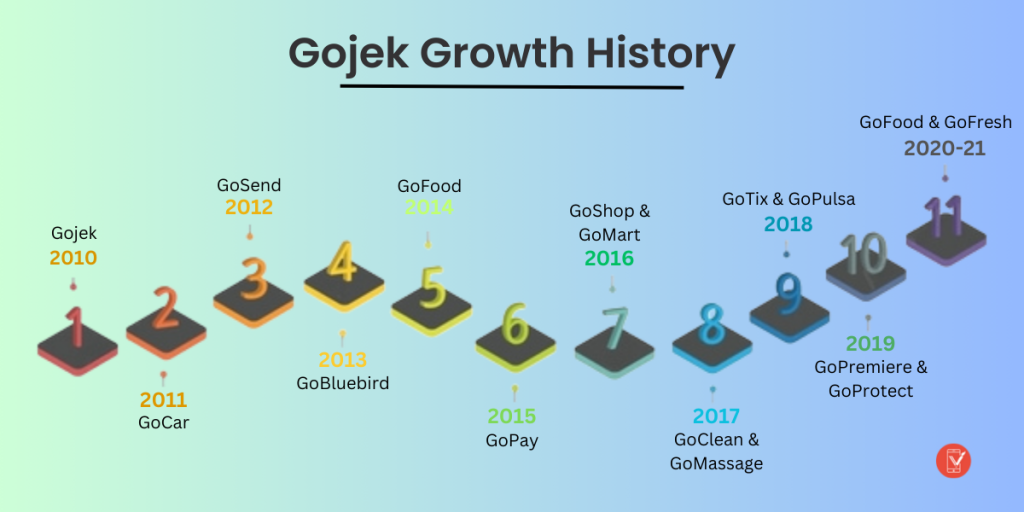
| Years | Achievements |
|---|---|
| 2010 | Nadiem Makarim, a young entrepreneur from Indonesia, founded Gojek, initially known as Go-Jek, as a motorcycle taxi service in Jakarta. The company started with a fleet of just 20 motorcycles. |
| 2011 | Gojek expanded its services to include on demand car taxi service, known as GoCar. |
| 2012 | Gojek introduced GoSend, an on demand courier service for sending packages and documents. |
| 2013 | Gojek’s user base reached over 1 million users. The company also partnered with Bluebird Taxi to offer a premium taxi service, GoBluebird. |
| 2014 | Gojek launched GoFood, an on demand food delivery service, revolutionizing the food delivery industry in Indonesia. |
| 2015 | Gojek expanded its services to other cities in Indonesia, including Bandung, Surabaya, and Bali. The company also introduced GoPay, a mobile wallet for cashless transactions. |
| 2016 | Gojek’s user base reached over 10 million users, making it one of the largest tech companies in Indonesia. The company also launched GoShop, an on demand shopping service, and GoMart, an on demand grocery delivery service. |
| 2017 | Gojek expanded its operations to Vietnam, Singapore, and Thailand. The company also introduced GoClean, a home cleaning service, and GoMassage, an on demand massage service. |
| 2018 | Gojek’s user base reached over 20 million users. The company also launched GoTix, an online ticketing platform, and GoPulsa, a mobile phone top-up service. |
| 2019 | Gojek introduced GoPremiere, an exclusive membership program for priority services and benefits. The company also launched GoProtect, insurance products for vehicles, travel, and other needs. |
| 2020 | Gojek faced challenges during the COVID-19 pandemic but adapted its services to meet the changing needs of its users. The company introduced GoFood Donation, a platform for ordering food donations to support those affected by the pandemic. |
| 2021 | Gojek continued to expand its services and partnerships, introducing GoMed, an online medical consultation and medicine delivery service, and GoFresh, a delivery service for fresh fruits, vegetables, and other perishable goods. |
| 2022 | Gojek remained a leading tech company in Southeast Asia, continuously innovating and expanding its offerings to serve the various needs of its users. The company also announced plans to invest in AI and ML to enhance its services further. |
Today, Gojek is a household name in Indonesia and other Southeast Asian countries, providing many services that have become essential parts of daily life for millions of people. The company’s success is a testament to its innovation, adaptability, and commitment to serving its users.
Key Statistics and Metrics of Gojek
As a super app originated in Indonesia, Gojek has witnessed an unbeatable success. From attracting millions of customers to making a considerable contribution to becoming Indonesia’s first decacorn, the brand has inspired many startups and enthusiastic entrepreneurs.
Some of the essential numbers of Gojek are as follows:
- GoFood (Gojek’s food delivery services) has over 9,00,000 merchants registered on its platform.
- It completed its 30 million trips in its first year of operation in Singapore.
- During the pandemic, GoFood crossed 190 million app downloads.
- Its taxi services have more than 2 million driver partners, rendering quick services to its customers.
- Gojek has over 40 million monthly active users.
These numbers prove that Gojek, with its engaging website and mobile app, has been able to pull in the target audience. Further, it provides numerous services under one platform, making it easy for app users to gain access to services quickly.
Range of Services Provided by Gojek
As mentioned above, Gojek is a super app. With its services in 3 countries and 20+ products, the brand is one of the leading on demand platforms. The brand has beautifully managed all these products and services by segregating them into different and relevant categories.
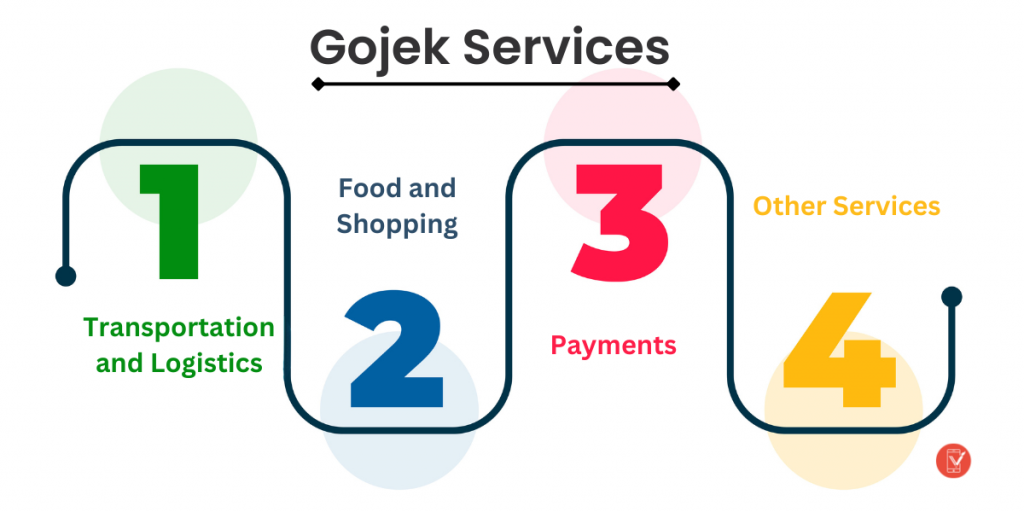
Here are all the services Gojek provides that make it easier for users to avail of all necessary services through a single platform.
1. Transportation and Logistics
Gojek on demand taxi services are the leading services in Indonesia. People rely heavily on its quick and reliable cab services.
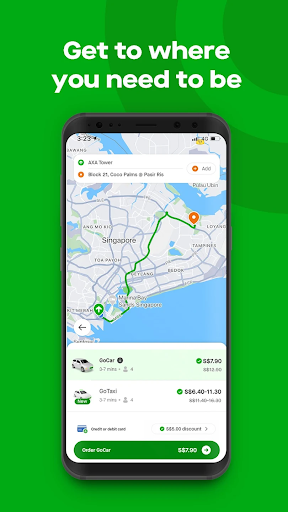
Source: Google Play Store
- GoRide: on demand motorcycle taxi service for quick and affordable transportation.
- GoCar: on demand car taxi service for comfortable and convenient rides.
- GoSend: on demand motorcycle delivery service for sending packages, documents, and other items.
- GoBluebird: Exclusive partnership with Bluebird Taxi for a premium taxi experience.
- GoTransit: A commuting assistant that integrates with public transportation options.
- GoBox: Services to help customers move their furniture and other stuff.
2. Food and Shopping
Another excellent service rendered by Gojek is the seamless food delivery and shopping. From ordering food online to delivering directly from stores, the Gojek platform takes care of it all.
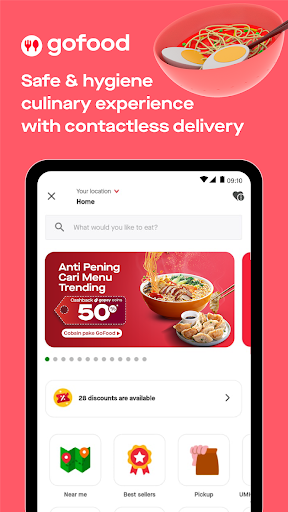
Source: Google Play Store
- GoFood: On demand food delivery service from a wide range of restaurants and eateries.
- GoMart: Grocery delivery service from supermarkets and convenience stores.
- GoMall: On demand shopping service for buying items from stores, pharmacies, and other retailers.
- GoFresh: Delivery of fresh fruits, vegetables, and other perishable goods.
- GoMed: Online medical consultation and medicine delivery service.
💡 Build an on demand food delivery app with our leading services. Get in touch with us today.
3. Payments
The platform makes it easy for users to receive and make payments. Its features allow users to keep complete track of their expenses.
- GoPay: Mobile wallet for cashless transactions, online payments, and bill payments.
- GoPayLater: Buy now, pay later service for flexible payment options.
- GoBills: Bill payment service for utilities, credit cards, and other bills.
- GoGive: Donation platform for supporting various causes and charities.
- GoSure: Insurance products for vehicles, travel, and other needs.
- GoInvestasi: Smart investment platform to save better.
4. Other Services
Other than services like food, taxi, shopping, payments, etc. Gojek provides more benefits. The list includes:
- GoClean: Home cleaning service for professional and convenient cleaning.
- GoMassage: on demand massage service for relaxation and stress relief.
- GoTix: Online ticketing platform for events, concerts, and attractions.
- GoPulsa: Mobile phone top-up service for prepaid SIM cards.
- GoPremiere: Exclusive membership program for priority services and benefits.
Gojek Business Model – How this Super App Works?
You must wonder how a brand providing various services manages to align its business operations. Gojek’s business model is simple and makes it easier for customers and merchants to interact.
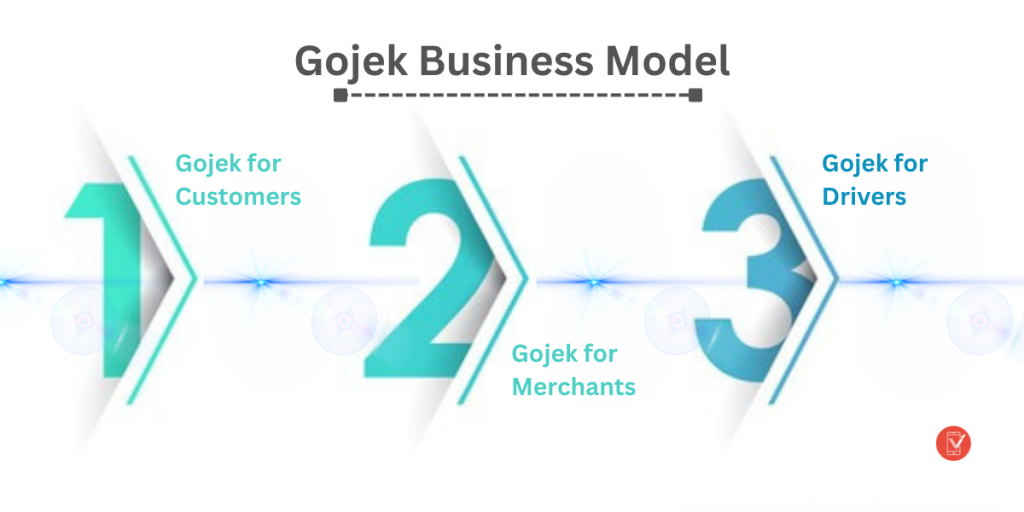
Let’s begin by looking at how the app works for the customers.
1. Gojek for Customers
Service selection
After downloading the Gojek mobile app, users can choose from a number of services. They can access various options, including shopping, food delivery, ride-hailing, courier services, and more.
Booking and payments
Users must first choose the appropriate service category, fill in the required fields (such as the location for rides or the things they want to be delivered), and finally, use the app to make a reservation. Gojek’s digital wallet, GoPay, or other payment options built within the site can be used to make payments.
Real-time tracking
Customers can use the Gojek app to track the position and status of their service provider in real-time for services like food delivery or ride-hailing. This feature gives an approximate arrival time and improves transparency.
Reviews and ratings
Customers can rate and review their experience once a service is completed. This feedback mechanism enables other users to make wise judgments and contributes to making informed decisions to enhance service quality.
2. Gojek for Merchants
Onboarding
Retailers and eateries can collaborate with Gojek to reach a wider audience of customers. They must undergo an onboarding process to include their services in the Gojek platform.
Order management
After integration, retailers can get orders from clients via the Gojek app. They oversee these orders, prepare the needed goods, and ensure they are fulfilled or delivered on time.
Payment settlement
On behalf of the retailers, Gojek manages the payment procedure. The platform handles customers’ payments, and merchants get settlements according to the terms that were agreed upon—often after a commission for utilizing the Gojek platform is subtracted.
Marketing opportunities
Having a presence in the Gojek ecosystem offers retailers more visibility and marketing options. The platform’s user base and promotional capabilities can help them draw in more business.
3. Gojek for Drivers
Registration and approval
Drivers must register on the Gojek platform in order to offer services, such as delivery or ride-hailing. To make sure they fulfill the necessary requirements, they must go through a verification process.
Accepting requests
Drivers can access the app and begin accepting service requests after approval. Customers in close proximity submit ride requests to them for ride-hailing. They get requests to pick up and drop off things for delivery services.
Navigation and fulfillment
Drivers use the app to navigate the customer’s location or the specified destination. They also receive information about the services they need to provide, such as delivering food or transporting passengers.
Earnings and ratings
Based on the services they execute, drivers are paid. Usually, Gojek adds a commission to every transaction. Additionally, drivers could get gratuities from happy clients—customers rate drivers on the platform, affecting their visibility and prospects. The platform frequently uses a rating system.
👉 Build a similar business model and engage with various target audiences. Contact our team today to discuss the app idea.
Gojek’s Revenue Models- Understanding Monetization Strategies
How does Gojek make money? The brand follows various models to ensure good revenue.
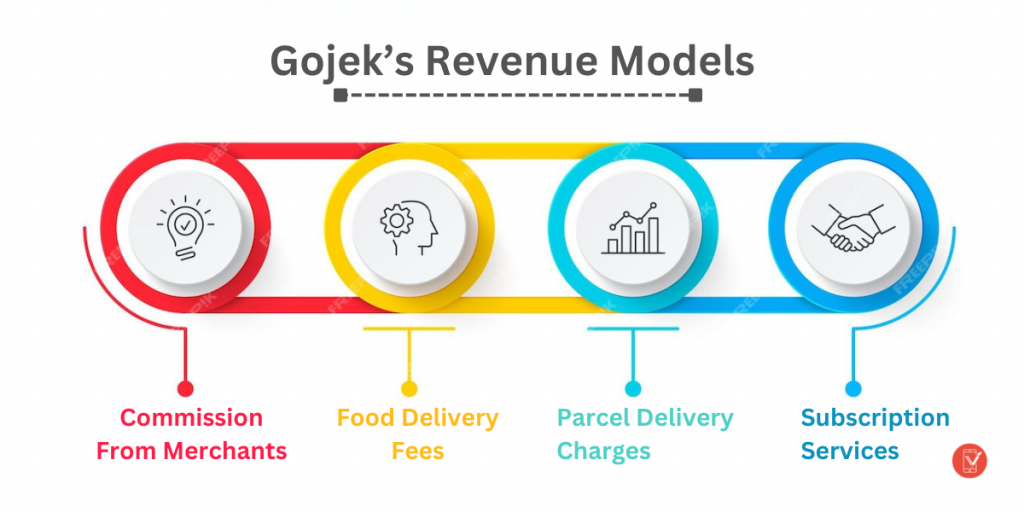
1. Commission From Merchants
Gojek has over 2 million drivers and over 4,00,000 GoFood merchants registered to its platform. The brand charges a commission fee on each order. So every time an order is placed, or a ride is booked, the Gojek brand earns money. For instance, it charges a 10% commission from drivers.
2. Food Delivery Fees
GoFood charges service and other fees during each order. Hence, with each food delivery order, Gojek earns revenue. This method is followed by all on demand food delivery apps to ensure a stable income.
3. Parcel Delivery Charges
Gojek earns revenue from the delivery fees for its parcel delivery services, alongside potential commissions from partnerships with businesses and individuals.
4. Subscription Services
Gojek also provides subscription services to its users. It has various plans that users can decide from. It allows the brand to receive a recurring payment from the subscribers.
With these monetization methods, Gojek ensures it gains good revenue on all its services.
Build Your Super App with ValueAppz
Do you also aim to target various target audiences with your one platform? You need a pro team like ValueAppz.
Our on demand app development services will ensure your brand gets precisely what it needs. Our experience in building food delivery apps, taxi booking apps, grocery delivery platforms, and so on enables our team to build a solid application every time.
Key Takeaways
- Gojek originated in Indonesia and now has over 40 million monthly active users.
- Gojek is a super app that provides various services like food delivery, online payments, taxi booking, news and entertainment, shopping, etc.
- Gojek’s business model allows the brand to keep its operations smooth and customers to avail quick services.
- The brand follows various revenue models like commission from merchants, delivery fees, commission from drivers, parcel delivery charges, and subscription services.
Frequently asked questions
Q1. What is the business model of Gojek?
Gojek’s business model is built around a multi-service platform that provides a range of on demand services, such as food delivery, transportation, logistics, and financial services. These services are integrated into a single app to meet a variety of customer needs.
Q2. What type of company is Gojek?
Gojek is a technology company that operates as a multi-service on demand platform. The company offers a range of services through its mobile app and website, such as food delivery, transportation, logistics, and payment processing.
Q3. Where does Gojek operate?
Gojek operates primarily in Southeast Asia, including countries like Indonesia, Vietnam, Singapore, and Thailand.
Q4. What technology is used in Gojek?
Gojek uses various technologies like JRuby, Java, Clojure, and Go clusters in Asia.
Q5. What makes Gojek unique?
Gojek’s unique characteristics include its broad range of services—from food delivery to transportation—all bundled into a single app and its emphasis on meeting the demands of Southeast Asia’s developing markets.
Q6. Can you name some apps that are similar to Gojek?
Some super apps similar to Gojek include Grab, Zalo, and Rappi.
THE AUTHOR
Mohit Yadav
As an expert in Digital Marketing, I always look forward to keeping up with the latest trends and customers’ changing demands. Hence, I focus on content that updates the readers in-depth about the industry.

Get ready to digitally transform your business.
Let our team help take your business to the next level. Contact us today to get started on finding the perfect solutions for your business needs.





